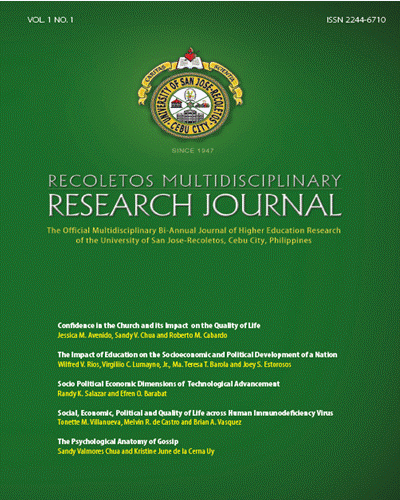The Ubiquity of Statistical Fractal Observations
DOI:
https://doi.org/10.32871/rmrj1301.01.11Keywords:
fractal, self – similar, statistical dataAbstract
The natural world is recognized to be fractal: from the growth of a leaf to how the trees propagate to form a forest, the neural networks, the DNA and the galaxies in space. The patterns and geometry that nature creates seem familiar and predetermined; actually it is random and unpredictable. It is this characteristic that made fractals a convenient method for such studies. Insights into the unpredictability could be a key in understanding the natural random events, like earthquakes, typhoons and other more subtle, natural occurrence like growths and cell developments. Data in different studies have always been thought of as normally distributed; however, recent investigations found that most of these statistical data are non-normal, and in a lot of cases are found to be fractal. According to Padua et al 2013, statistical fractal observations are random observations that possess stochastically self-similar patterns at various scale. In this light, this paper aims to illustrate the pervasiveness of statistical fractal observations in real-life by examining old data sets that used to be modeled in the framework of normal distribution theory. Samples of such observations will be presented in this paper.
References
Johnson, R. & Wichern W. (2000) Applied Multivariate Statistics, Wiley Series: New York.
Mandelbrot, B. (Ed.), The Fractal Geometry of Nature,
Freeman, New York, 1983, 14-57.
Stigler, S.M (1977). Do Robust Estimators Work with Real
Data?,The Annals of Statistics, 5(6), 1055-1098.
Box, G.E.P.,& Cox, D.R.(1964). AnAnalysisofTransformations, Journal of the Royal Statistical Society, B, 26, 211-246.
Padua, R., Adanza, J. G.& Mirasol, J. M.(2013). FractalStatistical
Inference. The Threshold, CHED-JAS Category A Journal, 36-44.
Padua, R., Barabat, E.& Regalado, D.Y.(2013). ASimpleTestfor Mono and Multifractality of Statistical Observations, NORSU Prism Journal of Higher Education, CHED-JAS Category B, 23-24.
Family Income by Class. National Statistic Office. (Retrieved February 22, 2013 from http://census.gov. ph/sites/default/ files)
Philippine Seismic Data: 2011 – 2013. (Retrieved May 9, 2013, from http://www.phivolcs.dost.gov.ph/html/update_SOEPD/EQLatest.html)
Selvam, A.M. (2008), Fractal Fluctuations and Statistical Normal Distribution.
Six Annual Fasting and One Hour Post Glucose Blood Sugars. (Retrieved April 16, 2013 from http://lib.stat.cmu.edu/datasets/Andrews)
Yield of Grain from Each of 1,500 Fifteen-foot Rows of Wheat. (Retrieved April 16, 2013 from http://lib.stat.cmu.edu/datasets/Andrews)
Downloads
Published
How to Cite
Issue
Section
License
Copyright of the Journal belongs to the University of San Jose-Recoletos


